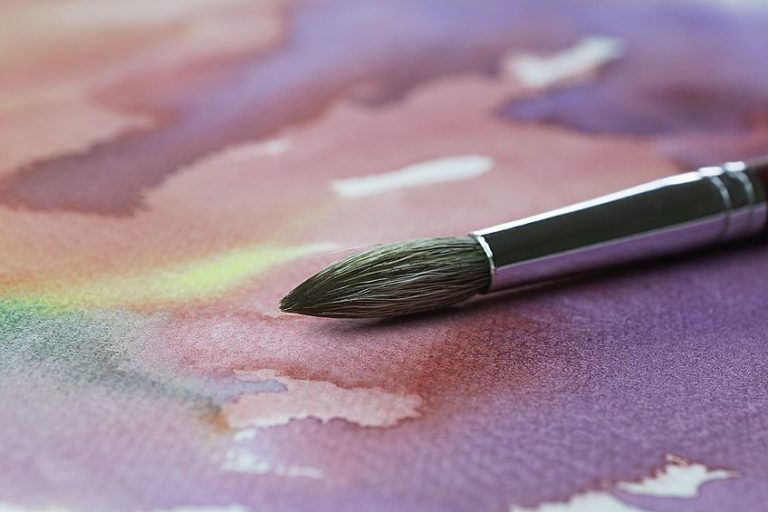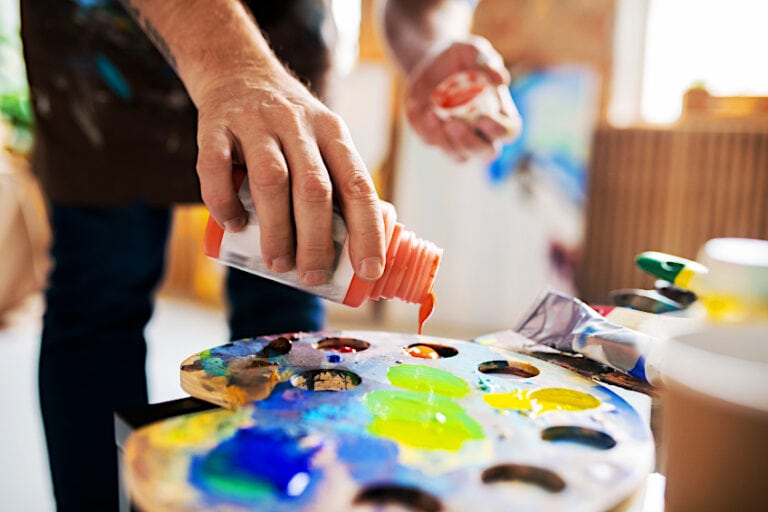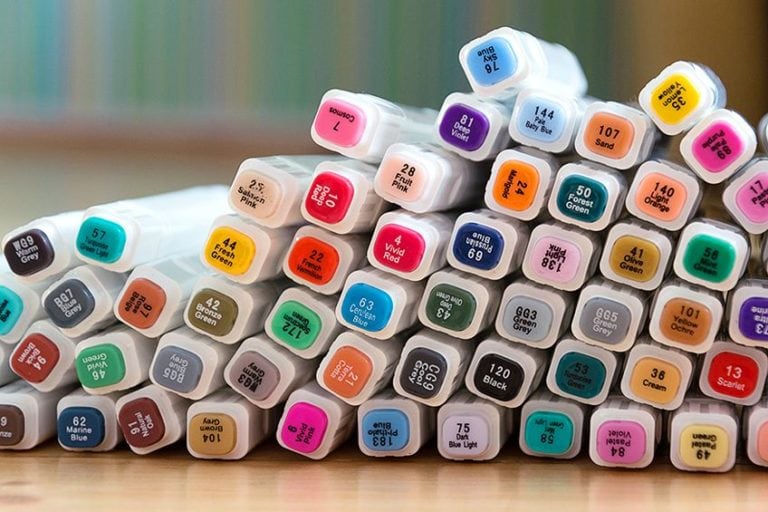Painting Ceramics with Acrylic Paints – Everything You Need to Know
This post may contain affiliate links. We may earn a small commission from purchases made through them, at no additional cost to you.
Are you looking to create a piece of art using either ceramics or clay? Your options to create any shape or form using ceramics are endless. You will have to take care and adhere to some procedures when working with ceramics. It is easy to work with ceramics, but there are a few aspects you will need to take into consideration if you hope to apply paint colors to your piece. This article will assist you in painting ceramics with acrylic paints.
Table of Contents
- 1 What Are Ceramics?
- 2 Painting Ceramics with Acrylic Paint
- 2.1 Tools and Equipment Needed for Painting Ceramics
- 2.2 Selecting the Correct Acrylic Paint for Pottery or Ceramics
- 2.3 Selecting the Perfect Brush When Painting Ceramics with Acrylic Paint
- 2.4 Applying the Paint for Pottery
- 2.5 Baking Your Ceramic Masterpiece
- 2.6 Applying a Sealing Coat
- 2.7 Painting Pottery with Added Effects
- 3 Tips and Tricks for Painting Ceramics with Acrylic Paint
- 4 Frequently Asked Questions
- 4.1 What Are Unpainted Ceramics?
- 4.2 Can You Safely Bake a Painted Ceramic Item in the Oven?
- 4.3 Must You Prime Your Ceramic Clay Surface Before Painting?
- 4.4 Is an Acrylic Painted Ceramic Piece Dishwasher Safe?
- 4.5 Is Acrylic Paint Waterproof?
- 4.6 Is Acrylic Paint Flammable?
- 4.7 Is Acrylic Paint Permanent?
What Are Ceramics?
Ceramics can be defined as a form of clay that has been heated, causing it to harden. When discussing any item made from ceramics, we are not necessarily referring to the material that was utilized to make the item, but instead, we are referring to the state in which the ceramic material is found.
To gain a better understanding, we will look more in-depth into the three stages a ceramic item goes through before it becomes an item that can be displayed or used.
Greenware Ceramics
This stage is known as the greenware or green stage. The clay has been air-dried at this point, but, has not been placed in an oven or kiln and subjected to fire. The clay is particularly fragile at this stage and you need to be very careful when handling it and it has a limited life span and is not particularly strong.

We suggest you do not apply any acrylic paint at this stage to the item.
The paint will sadly not adhere correctly to the clay at this stage, and secondly, even if the paint were to stick, there is no protection or strength to the product at this stage. The ceramic stage at this stage can be referred to as unpainted ceramics.
Bisque Ceramics
The unglazed state of the clay, also referred to as the bisque stage, means that the piece has been placed in a fire kiln once. This builds the piece’s strength and gives it structure. This is the perfect state you want your clay to be in to apply your paint.
The clay is particularly porous at this stage and the paint will soak into the clay, offering you the adhesion you require.
Glazed Ceramics
This stage means that the clay has been kiln-fired once, then the glazer or acrylic paint has been applied. It has then been fired in a kiln for the second time The second time in the kiln the temperature has been set higher.
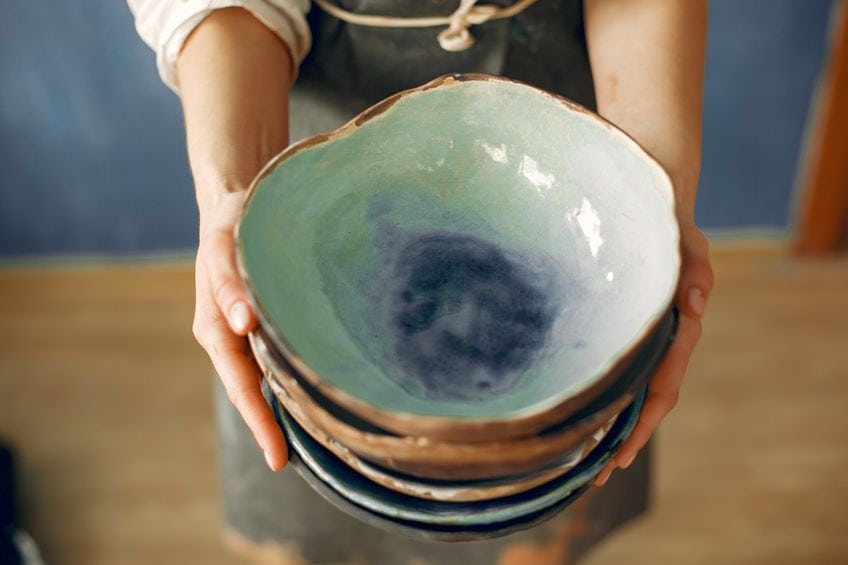
The process causes the glazer or paints to turn to a glass-like finish. It is then significantly more durable, whilst also becoming waterproof. This means the item will be able to take cold or heat, hold water, and be placed in the dishwasher or microwave. If your ceramic has already been fully glazed, do not then apply acrylic paints, as the paint will not adhere to the surface and it will scratch off with ease.
Keep in mind that it is recommended that you apply a sealing or topcoat over the paint after it has been glazed, as it will offer you additional protection.
Painting Ceramics with Acrylic Paint
Acrylic paint that has been created specifically for use on ceramics will allow you the opportunity to incorporate some brilliant and vibrant colors. You can also add your spin to your ceramic artwork. Acrylic paints are easy to use and are convenient, they are also simple to clean up when you are done. All you need is some water.
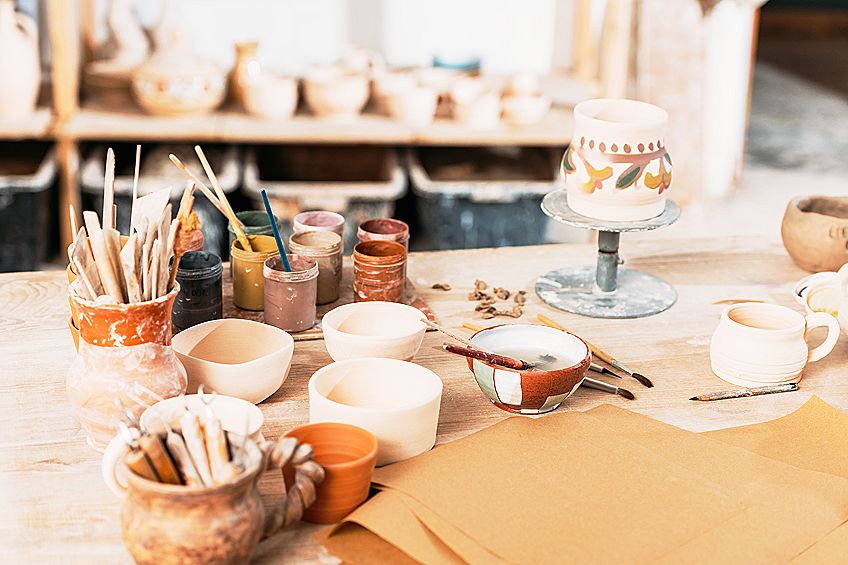
The majority of acrylic paints used for painting ceramics are non-toxic.
This means you can work with them inside and they are safe for both adults and children to use. Acrylic paints are manufactured in an assortment of colors, meaning you will always be able to find the perfect color for your project.
Tools and Equipment Needed for Painting Ceramics
Before you can begin painting your ceramics you will need to assemble all the relevant tools and equipment. You also want to set up your workspace or table so that there is as little wind or dust in that area as possible. You will require the following items:
- Oven or kiln to fire your completed piece of art
- Your ceramic item
- Soft-bristled paintbrush
- Paper plate or painting palette
- Clear spray sealant
- Paintbrush
- A variety of acrylic paints

Remove any ceramic dust, powder, or any stray particles from the bisque stage of your piece of ceramic, using the soft-bristled paintbrush. If this is not done sufficiently then you may be left with an uneven finish on your artwork.
Use some fine-grit sandpaper on any rough areas of your ceramic piece, creating a smooth surface.
Selecting the Correct Acrylic Paint for Pottery or Ceramics
In today’s market, there are so many different paint varieties available. However, not all paints will work well on ceramics. Certain paints will not adhere to the surface, appearing translucent, leaving streaky marks, or leaving an overall unpleasant finish. So, what is the best acrylic paint on ceramics?
You ideally want acrylic paint that has been specifically formulated for painting on ceramics.
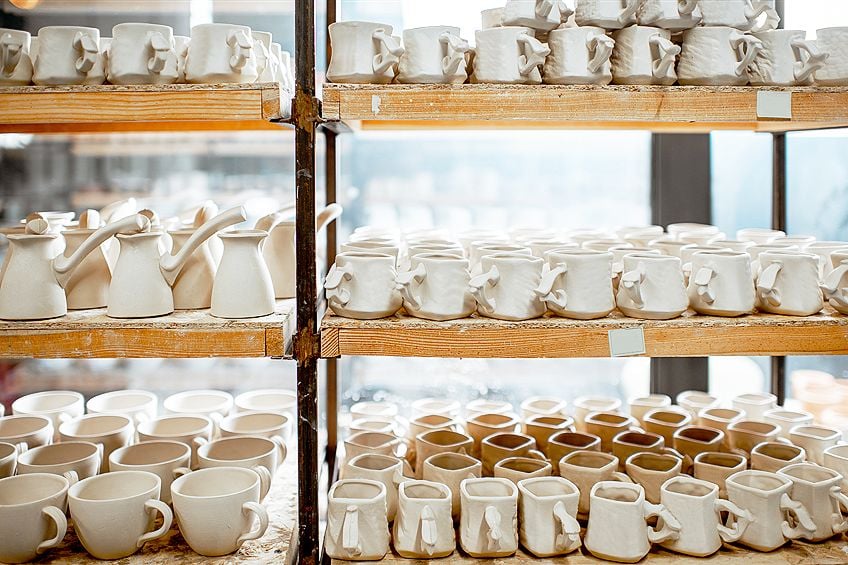
These paints will be available to purchase at your local hardware store or crafts store. You want a paint that is non-toxic and water-based, so it can be used around food and will be able to hold hot beverages.
You will need to ensure that you have selected the correct acrylic paint color for your needs. You only need to load a small quantity of paint onto your paper plate or palette. If you happen to run short you can simply add a little more color as required.
Best Acrylic Paint for Ceramics: LIQUITEX Professional Acrylic Paint Set
This paint set is thought to be one of the best on the market, and is also one of the safest backable acrylic paints you can purchase on the market today. In 1955, Liquitex produced its first water-based, artist acrylic paint formulation. Since then, they continue to offer a product that is ideal for professional artists’ requirements.
They offer a range of versatile acrylic paints that can be applied to several different surfaces including fabric, canvas, glass, paper or board, wood, plaster or brick, and clay. The paints offer an intense, permanent, and highly-loaded color.
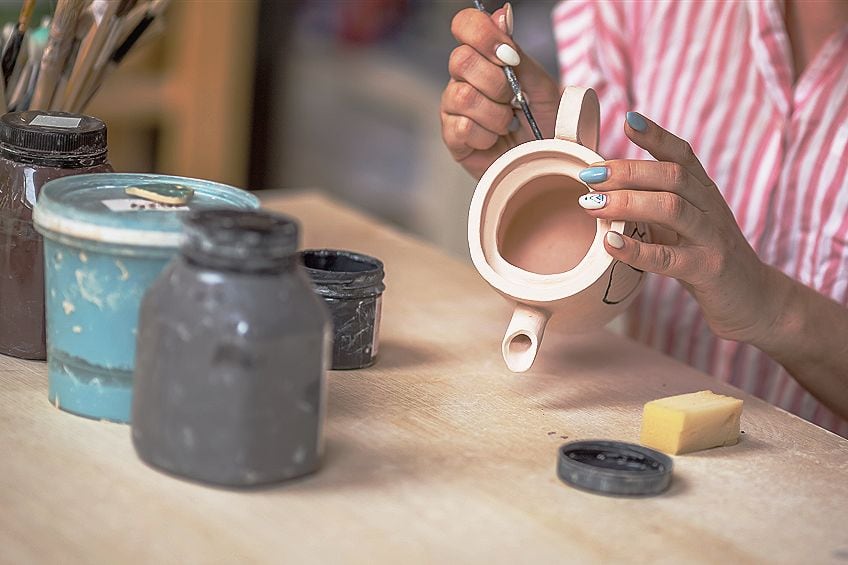
There are four unique ranges of acrylic paint available from this brand that fit the requirements of the artist. They have a low-odor acrylic resin that is at the forefront of acrylic resin technology, which provides colors that offer stunning clarity, they are durable, non-yellowing, and highly flexible. When the paint is dry it provides resistance to UV and water, while also being PH neutral.
- Basic palette suitable for a beginner, student, or professional artist
- Paint has a high viscosity, blends very easily, and is non-cracking
- Highly pigmented paints that dry with a satin finish
Any Liquitex color can be combined with other mediums available from Liquitex. This acrylic paint has a high viscosity and is heavy-bodied, with a thick consistency. It is therefore ideal to use with knives or brushes. Should you attempt impasto applications, your brushstrokes will remain crisp and so will your knife marks.
The paint has an increased open-working time and offers stunning handling and blending qualities.
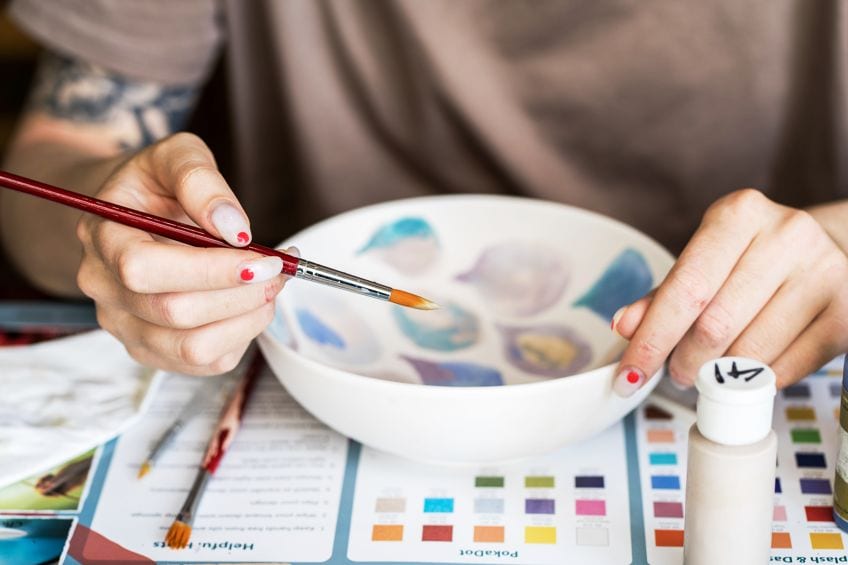
This particular set of Liquitex acrylic paints is highly pigmented and offers a permanent, brilliant, and rich color that has a semi-opaque, natural opaque, or transparent finish. The set is available in as few as 12 colors, all the way up to 105 colors!
Finally, the amazing archival qualities should be noted as the heavy body pigment has been through extensive testing for lightfastness. In addition, all the pigments are rated in line with the American Society for Testing & Materials (ASTM). This means that if you use Liquitex Heavy Body Acrylic Paints to complete your artwork you will achieve stunning durability and archival stability.
PROS
- Durable
- Non-toxic
- UV resistant
- Low odor
- Water-resistant
- Perfect for brush painting
- Can be applied to glass, wood, and many more materials
- Lightfast pigments
- Highly versatile on clay and canvas
- Available in 105 colors
- Will not crack or chip when dry
- Thick consistency
- High pigment load
CONS
- Certain Liquitex products not available in all locations
- More expensive than other acrylic paints on the market
Selecting the Perfect Brush When Painting Ceramics with Acrylic Paint
When painting with acrylic paints you can use any type of brush, but there are certain differences you need to take note of. Soft sable or hog bristle brushes, those which are natural-hair bristle brushes, are normally used by oil painters. This is thanks to the fact that they can hold heavy textured paints, while still retaining their shape.
However, with extended use, the natural-hair bristle brushes may be damaged by acrylic paints.
Natural-hair bristle brushes can also lose their shape and become damaged when they are allowed to sit in water for any length of time. The alternative option is to use synthetic-bristle brushes, which are normally made from nylon or polyester, and are available in an assortment of stiff and soft bristle brushes.
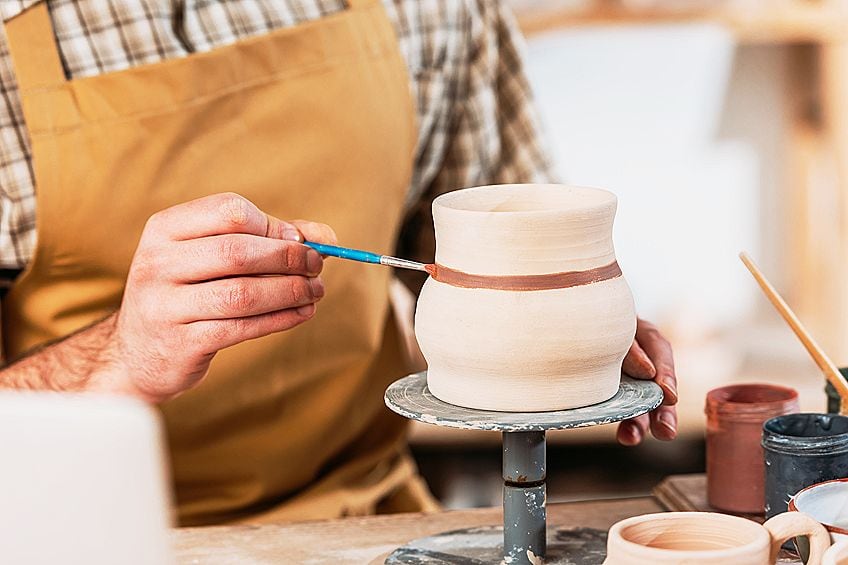
The synthetic-bristle brushes are better suited for acrylic paints as they handle the acrylic resin very well. These brushes are a lot easier to clean and will not become damaged if left sitting in water for any period. That being said, they do not maintain their shape as well as the natural-bristle brushes, although they do cost a lot less and are durable.
When applying acrylic paint to ceramic, we recommend you use synthetic-bristle brushes. You will need to take into consideration any special effects you wish to create when selecting a brush to use with your acrylic paints. When blending, the soft synthetic brushes leave a smooth finish, while you will be left with a more visible brush mark when using stiffer brushes and offer more texture.
If you are painting a flat surface area, we recommend using a nylon brush. However, if you are looking to create more texture, you should use a natural bristle brush.
Applying the Paint for Pottery
Before you begin painting the pottery, you should use spray paint to prime the surface. In doing this, you will end up using less paint when you start painting. You can use either flat spray paint or some gesso as a primer.
This will stop the paint from soaking into the surface too fast, as the fired ceramic surfaces are extremely porous.
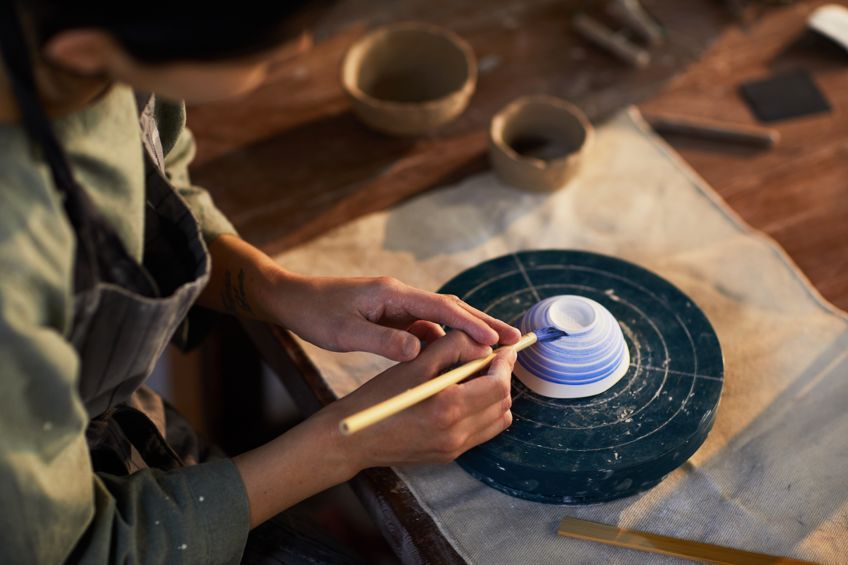
We also recommend you first sketch the figure or design you are planning to paint onto your ceramic, this will make it a lot simpler to paint. As acrylic paints dry very quickly and are very versatile, you will need to apply them directly from the tube and in thin layers. The first layer needs to be completely dry before you can apply the second layer. If you are working with different colors, we suggest you begin with the darker colors and afterward, apply the lighter colors. This will create the contrast you are looking for.
You can try different strokes, either gentle or hard strokes to form a weathered look.
Baking Your Ceramic Masterpiece
The majority of acrylic paints available are bakeable, meaning they can be baked in either a kiln or an oven. However, we suggest you read the manufacturer’s instructions first to ensure that the acrylic paint that you are using is non-toxic, bakeable, and can be used in the oven.
You can bake your ceramic items in a firing kiln, but this process takes a long period and if you do not own the correct equipment, it will cost you a lot of money. You can instead use your own oven.

If you are just working with a smaller item, a toaster oven will even work. The baking process is simple enough to do and can even be done by a beginner or even by a child. The baking process will decrease the drying time of the paint, while also hardening the acrylic paint. This is especially helpful when you are painting multiple layers of paint. It can take a long time for the paint to dry when you are painting multiple layers.
This is when the baking process is useful: just put your item in the oven, allow time for it to cool down, and you can then go on with your painting, saving yourself a fair amount of time.
Baking Methods
We had previously mentioned that the baking process is quite easy to do, and can even be done by children, but you may wonder what the baking process is exactly? We have put together the relevant steps to assist you with the baking process, to create an item that can be used for drink and food.

- To begin with, you will need to ensure that the acrylic paint which has been applied to your ceramic piece is completely dry. To ensure this, you should leave your item for roughly 24 hours when you have finished painting it.
- While the oven is still cold, place your item in it. This will allow the item to heat up slowly, as the oven heats up, and your piece will not crack and break.
- The oven temperature needs to be set to 350 degrees Fahrenheit (176 degrees Celsius).
- Allow the item to bake for half an hour.
- After half an hour, switch the oven off and leave the item in the oven. The piece should be allowed to cool down slowly while the oven cools.
- Take the item out of the oven. Allow the piece to stand for three days before starting to use it.
Another Method for Drying Acrylic Paint on Ceramics or Pottery
Acrylic paints are simple to use, dry quickly, and well-priced. However, not all acrylic paints can be used near food, or are heat resistant. We have put together a few tips to assist in drying your craft acrylic paint faster.
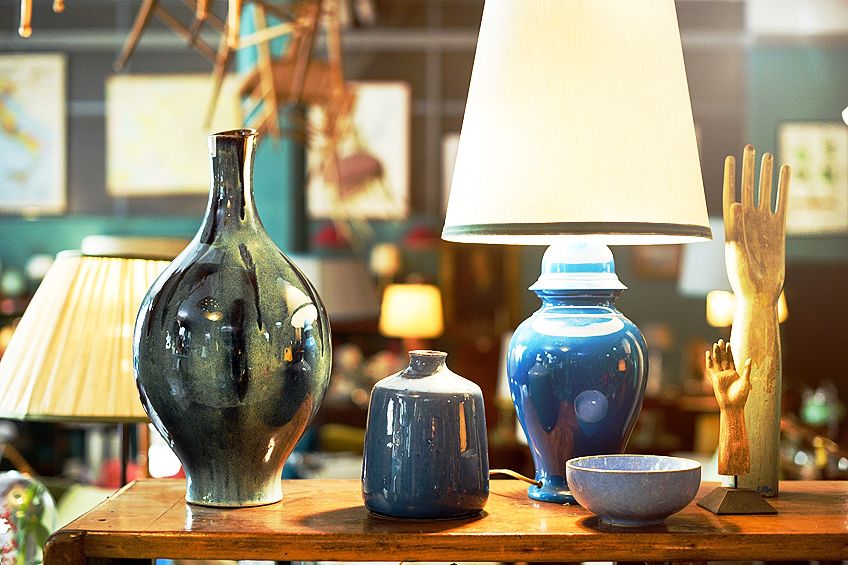
- Good ventilation will speed up the drying time. Switch on any fans, open all the windows and do what you can to increase the airflow to speed up the drying time of your acrylic paint.
- The drying time will be impacted by the temperature. A higher temperature will dry the paint faster. So go ahead and turn on the heater in your workspace.
- Apply thinner coats when painting with acrylic paints. Thinner coats will dry a lot faster.
- Your paint will run and become thinner in higher humidity. Use a dehumidifier to decrease the humidity, or if you live in a dry climate, you can open the window.
- There is fast-drying acrylic paint available on the market. This will of course save you a lot of time.
- Use your hairdryer, a heat gun, or even a heat lamp. All these devices can speed up the drying time.
- Be patient when drying your acrylic paint. If you apply too much heat you can potentially damage the paint finish, or cause discoloration or bubbling.
Applying a Sealing Coat
You may wonder why you would need to seal your ceramic before baking it. To simply put it, it is to increase the item’s durability. If the acrylic paint is not sealed, it will not last that long and will quickly start to flake and peel off. In addition, if you have painted a plate, cup, or mug, then the paint could come off and taint your food or drink, as acrylic paint is water-soluble.
You need to use a sealant that is high-quality and, of course, food safe.

A water-based varnish will provide you with great protection and is perfect to use when you need to seal smaller items such as ceramic cups or mugs. Another option is a water-based varnish, which will offer a tougher finish, but this can be hard to clean and gives off a strong odor. You can also use Mod Podge, a clear acrylic topcoat, or a polyurethane varnish, which you can either spray on or apply with a paintbrush.
The Best Sealing Method
You can begin by ensuring that your ceramic item is completely cured in the oven and allow sufficient time for it to cool down before you begin applying the sealing layer. Ensure you have your sealing product at hand.

- Put some plastic sheeting down or some newspaper. This will protect your work area.
- Place the item on the newspaper or sheeting.
- You can begin to apply the sealant. Ensure you apply a thin coat and that the whole item has been covered in sealant. You can apply the sealing coat using either a brush or by spraying it on.
- If you are sealing either a mug or a cup, ensure that you get none of the sealants inside the mug or cup. Also, you want to avoid putting sealant right up to the top of the cup where it can potentially come into contact with your mouth.
- Allow sufficient time for the sealant to dry. It should take roughly 15 minutes, though some sealants may take even longer to dry.
Painting Pottery with Added Effects
A lot of potters enjoy adding additional color effects to their pottery pieces. In doing so they use a ceramic medium as opposed to paint. These include oxide stains, underglazes, and slips (a slip is a type of liquid clay).
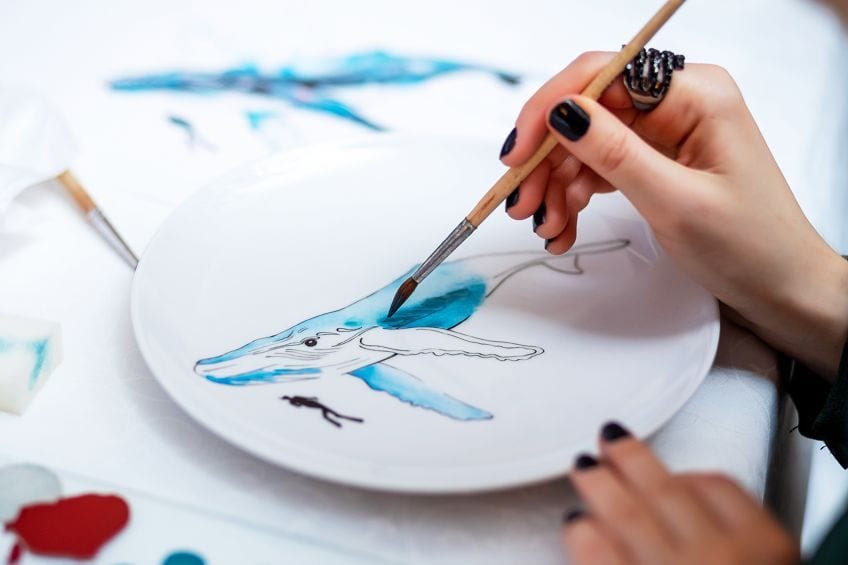
All these mediums will fuse to the pottery surface after being fired and will not flake off or wear away. Keep in mind though that this type of embellishment is intended for display purposes only and not for functional use.
Tips and Tricks for Painting Ceramics with Acrylic Paint
We have put together a few tips and tricks to assist you when using acrylic paint for ceramics. The most important thing to note is whether to paint already glazed or unglazed ceramic items. If the item has already been glazed, then it is water-proof, meaning there will be very little adhesion capabilities for your acrylic paint.
Therefore, we recommend that you do not apply acrylic paint to items that have already been glazed.
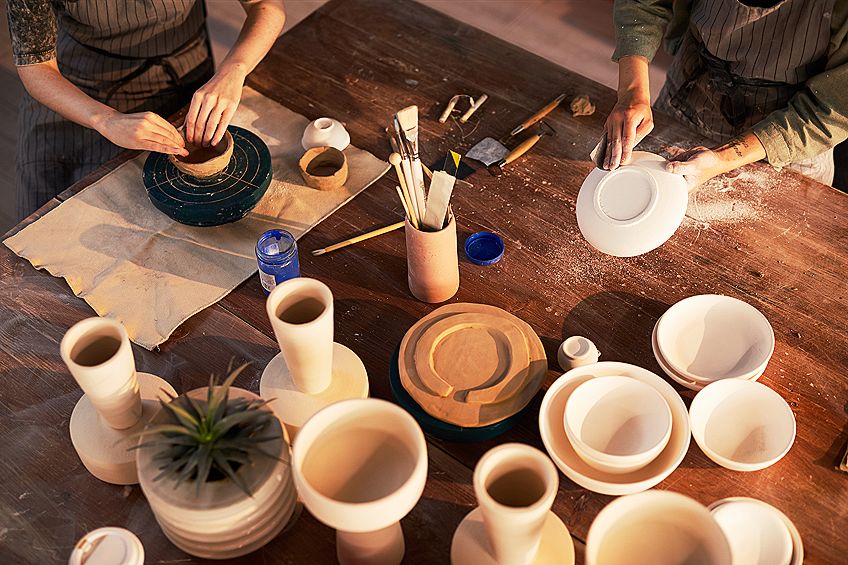
- We suggest you only apply acrylic paint to unglazed items. This will aid the adhesion of the paint.
- When placing your ceramic items in the oven ensure that the oven is still cold. This will ensure that the item does not crack.
- Always paint from light to dark, do not paint your dark colors first.
- Use a pencil when drawing your image on your item before painting. When you place the item in the kiln the pencil will come off, leaving no marks behind.
- You can add texture, but incorporate an assortment of painting techniques.
- Ensure the paints you are using are formulated for painting pottery.
There are a variety of techniques and methods you can use when painting ceramics using acrylic paints, just have fun and experiment as you go. Use your creativity and imagination to use different ways of producing some stunning art pieces. Just be careful when decorating mugs, ensure that the products that you are using are both food-safe and non-toxic.
Frequently Asked Questions
What Are Unpainted Ceramics?
This refers to a state of ceramics whereby they are not ready to be painted on. The state the ceramics are in at this stage is called greenware or green state.
Can You Safely Bake a Painted Ceramic Item in the Oven?
You will have to consult the manufacturer’s instructions to determine if the paint you are using is non-toxic, and can be baked in an oven. But yes, you can place a painted ceramic piece in the oven, provided you are following the recommended process.
Must You Prime Your Ceramic Clay Surface Before Painting?
We recommend that you prime the surface of your ceramic item due to ceramics being porous. In doing so, you will save a lot of paint, as when the surface is primed, less paint will be absorbed into it. The primed surface also provides you with better adhesion.
Is an Acrylic Painted Ceramic Piece Dishwasher Safe?
Your item will be safe to place in the dishwasher if you have applied the acrylic paint and baked the item in the oven to seal it. However, you will have to wait for roughly 72 hours before you wash the item.
Is Acrylic Paint Waterproof?
Once the acrylic paint has dried, it is water-resistant but not water-proof. To ensure that it is water-proof, you will need to apply a sealing coat.
Is Acrylic Paint Flammable?
If you are using water-based acrylic paint then it is not flammable, meaning it is also travel-safe. While acrylic paints are very safe to use, when working with children rather use craft paints.
Is Acrylic Paint Permanent?
Once your acrylic paint has dried completely, it is then permanent. Thanks to the paint texture being highly flexible, it will adapt to your ceramic piece’s surface and will not crack or chip. To increase the durability you will, however, have to seal your item.
Larissa Meyer is a 32-year-old mother from Michigan and creative spirit since childhood. Her passion for painting and drawing has led her to an education as an illustrator and a career as a freelance graphic designer. She has a Bachelor of Fine Arts in Illustration and a degree in Graphic Design. Larissa is a talented artist who is able to master a wide range of styles and techniques to bring her artistic vision to life. Her greatest passion is currently fluid painting and epoxy resin art. Larissa’s love for art and her knowledge and experience in illustration make her the perfect Creative Director for our fluid-painting.com team. She is the creative head of our team and shares her passion and knowledge with our community through articles and tutorials.
As a mother of a 2-year-old daughter, Larissa also understands the importance of fostering creativity in early childhood. She uses her experience and knowledge to help other parents inspire their children and develop their artistic skills as well.
Learn more about Larissa Meyer and about us.




